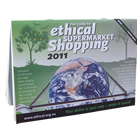
1. Avoid unnecessary consumption. Ask, 'Do I need it?'
Where possible, avoid unnecessary consumption. About 80% of all saleable products end up as waste, on average, within just 6 months. How we buy will influence directly what we buy so it is important to think about the way we spend money. Is the purchase based on need, importance, urgency, or impulse? Do I really need this? How much is enough? Can it be borrowed? Or sourced from a retailer with environmental credentials?
Make a preferred shopping list and keep to it. By planning ahead and anticipating the goods and services we will need - rather than making impulse buys - we give ourselves more time to find the most socially and environmentally responsible alternatives.
2. Remember, every purchase makes an impact, your choice makes a difference!
You make a difference. To shop with a conscience is to start to see the connections we have with the environment around us. Whatever the product, it will have or has had, some impact on the environment somewhere. However with each conscious choice we can minimise this impact.
Often you can feel that your small purchase doesn't really matter, you are 1 person amongst a world of 6 billion. In fact, it is because each small purchase does have an impact and there are 6 billion people that it adds up to one big difference. It is actually because each of our purchases do count, that we are in the environmental crisis of today.
3. 'What is the Real cost? Learn about the issues, see the connections, take on one issue at a time'.
Learn about the issues.
What are the issues or aspects of sustainability that relate to this particular product? See the chart as an example of some issues related to products in the supermarket.
Take on one issue at a time.
It's easy to be overwhelmed with the complexities of issues and the lack of adequate information. Remember that each positive choice makes a positive difference. By thinking about the issues and making abest choice you are taking responsibility for the impact of your purchase. This week start with one item, say milk, and find out the issues and best alternatives. It only takes 20 days to change a habit.
What is the real cost?
For most people, most of the time, 'cost ' and 'convenience' are the main reasons we buy what we do. These aren't bad reasons, but don't reflect the true cost to the environment and people of the things we purchase. It's worth asking, "how much extra am I prepared to pay today to minimise my impact?" Will it be 5%, 10% or more? Keep in mind too that each dollar spent on more sustainable products and services increases the demand for them.
4. Seek out the Best Buy according to what you value and the options available
There are no right or wrong purchasing decisions. Rather it depends on 'what you value' as to those you will find are most important. Mostly it is not possible to find a product that meets all the criteria that we could choose, so it's important to prioritise our values. You might decide to buy local over organic, or choose to buy with minimal packaging over local.
Often cost and convenience, taste and appearance are primary motivators for purchasing choices. However in reality most people value things that are much more fundamental. When asked to trade off the natural beauty and biodiversity of our forests for toilet paper, or clean air for that extra car trip, it's not a simple choice. However we often don't see the connections and are overwhelmed or paralysed by the complexities.
In finding a better choice you will need to consider what you value, but also what products are available from among the options on hand. Also it's no good choosing choosing an item with all the right "ethical" or "environmental" criteria if its not available at the particular store you are buying from. It's also important to make sure it will do the do the job you need it for.
5. Make lasting change – celebrate good choices, make them into good habits, give feedback
Celebrate good choices. Each good choice makes a world of difference. You are taking responsibility for the impact of your purchase.
Create good habits. It's looks like a huge task to change your shopping patterns, but once you've found a best buy, remember it and move onto the next product type on your list or issue to address. It only takes 20 days to change a habit, so take on one issue at a time.
Give feedback. Let those companies know, via letter or email, of the choices you have made. Real change can only come with communication and encouragement. You are not only supporting and encouraging sustainable practice, but also you are exercising your consumer power.
Share your discoveries. Change starts with you but it doesn't end there. Perhaps you can encourage those around you to review their approach to shopping?
No comments:
Post a Comment